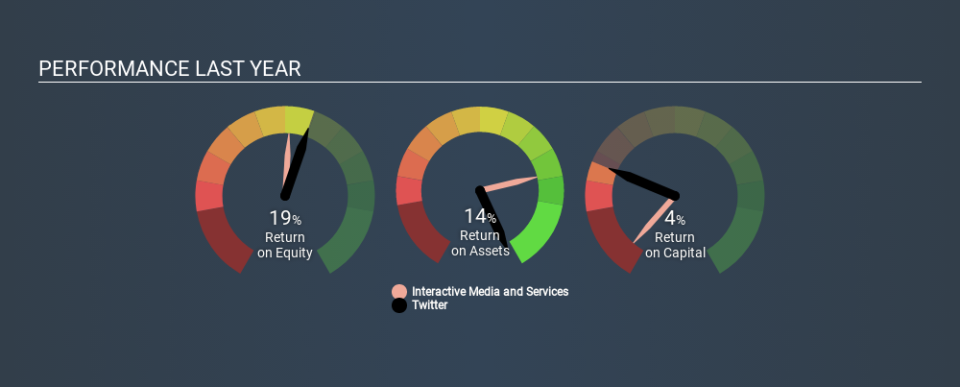Should Twitter, Inc.’s (NYSE:TWTR) Weak Investment Returns Worry You?

Today we are going to look at Twitter, Inc. (NYSE:TWTR) to see whether it might be an attractive investment prospect. To be precise, we'll consider its Return On Capital Employed (ROCE), as that will inform our view of the quality of the business.
First up, we'll look at what ROCE is and how we calculate it. Second, we'll look at its ROCE compared to similar companies. And finally, we'll look at how its current liabilities are impacting its ROCE.
What is Return On Capital Employed (ROCE)?
ROCE is a measure of a company's yearly pre-tax profit (its return), relative to the capital employed in the business. In general, businesses with a higher ROCE are usually better quality. Overall, it is a valuable metric that has its flaws. Author Edwin Whiting says to be careful when comparing the ROCE of different businesses, since 'No two businesses are exactly alike.
How Do You Calculate Return On Capital Employed?
Analysts use this formula to calculate return on capital employed:
Return on Capital Employed = Earnings Before Interest and Tax (EBIT) ÷ (Total Assets - Current Liabilities)
Or for Twitter:
0.039 = US$425m ÷ (US$12b - US$763m) (Based on the trailing twelve months to September 2019.)
Therefore, Twitter has an ROCE of 3.9%.
Check out our latest analysis for Twitter
Does Twitter Have A Good ROCE?
One way to assess ROCE is to compare similar companies. We can see Twitter's ROCE is meaningfully below the Interactive Media and Services industry average of 9.1%. This performance is not ideal, as it suggests the company may not be deploying its capital as effectively as some competitors. Putting aside Twitter's performance relative to its industry, its ROCE in absolute terms is poor - considering the risk of owning stocks compared to government bonds. There are potentially more appealing investments elsewhere.
Twitter has an ROCE of 3.9%, but it didn't have an ROCE 3 years ago, since it was unprofitable. That suggests the business has returned to profitability. The image below shows how Twitter's ROCE compares to its industry, and you can click it to see more detail on its past growth.
When considering ROCE, bear in mind that it reflects the past and does not necessarily predict the future. Companies in cyclical industries can be difficult to understand using ROCE, as returns typically look high during boom times, and low during busts. ROCE is, after all, simply a snap shot of a single year. Future performance is what matters, and you can see analyst predictions in our free report on analyst forecasts for the company.
What Are Current Liabilities, And How Do They Affect Twitter's ROCE?
Short term (or current) liabilities, are things like supplier invoices, overdrafts, or tax bills that need to be paid within 12 months. The ROCE equation subtracts current liabilities from capital employed, so a company with a lot of current liabilities appears to have less capital employed, and a higher ROCE than otherwise. To counteract this, we check if a company has high current liabilities, relative to its total assets.
Twitter has total liabilities of US$763m and total assets of US$12b. Therefore its current liabilities are equivalent to approximately 6.6% of its total assets. Twitter has very few current liabilities, which have a minimal effect on its already low ROCE.
What We Can Learn From Twitter's ROCE
Nevertheless, there are potentially more attractive companies to invest in. But note: make sure you look for a great company, not just the first idea you come across. So take a peek at this free list of interesting companies with strong recent earnings growth (and a P/E ratio below 20).
For those who like to find winning investments this free list of growing companies with recent insider purchasing, could be just the ticket.
If you spot an error that warrants correction, please contact the editor at editorial-team@simplywallst.com. This article by Simply Wall St is general in nature. It does not constitute a recommendation to buy or sell any stock, and does not take account of your objectives, or your financial situation. Simply Wall St has no position in the stocks mentioned.
We aim to bring you long-term focused research analysis driven by fundamental data. Note that our analysis may not factor in the latest price-sensitive company announcements or qualitative material. Thank you for reading.

 Yahoo Finance
Yahoo Finance 
